DONALD TRUMP
 (1946 to today)
(1946 to today)
 (1946 to today)
(1946 to today)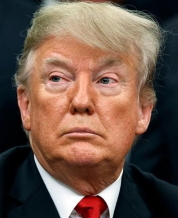
 Trump's recent ancestry
Trump's recent ancestry
 Trump's youth and business startup
Trump's youth and business startup
 And the building projects (and other
And the building projects (and other
projects as well) continue
TRUMP'S RECENT ANCESTRY |
TRUMP'S YOUTH AND BUSINESS STARTUP |
|
Donald Trump's youth Donald was born in June of 1946 and grew up with his mother and father and four siblings in Queens, attending the fashionable Kew-Forest prep-school from kindergarten up through the seventh grade. But in 1959, at age 13, he was sent to the New York Military Academy (NYMA) in an attempt to bring some of his wilder ways under strict discipline (he was hard to manage and was making frequent trips into Manhattan without permission). At the NYMA he proved to be an outstanding athlete, competing in everthing from soccer, to baseball, to wrestling, to basketball ... and proving himself to be a leader in various student functions. He graduated from NYMA in 1964 and entered Fordham University ... but transferred to the Wharton School at the University of Pennsylvania in Philadelphia - to study the real estate business. Like his father, Donald combined studies with business, working with his father's real estate company. For instance during his college years he and his father were able to buy up the forclosed Swifton Village apartment complex (suffering from a huge non-occupancy rate) in Cincinnati, Ohio, and together put it back up and running to full occupancyy In 1968 he graduated from Wharton with a degree in economics. |

Donald Trump (leftmost) with his bothers and sisters, Fred Jr., Robert, Maryanne and Elizabeth

Donald Trump with his father Fred and mother Mary Anne at the New York Military Academy

Donald Trump senior yearbook picture at the New York Military Academy - 1964

Donald Trump (fourth from left) and the New York Military Academy soccer team
 Donald Trump (again, fourth from
left)
and the
New York Military Academy soccer team
Donald Trump (again, fourth from
left)
and the
New York Military Academy soccer team

Donald Trump and his
father Fred
at Donald's graduation
from the Wharton School at the University of
Pennsylvania - 1968

Trump and his real-estate developer father at Trump Village, Brooklyn - 1975
|
His entry into the business world Whereas Donald Trump's father Fred had devoted himself to the construction of basically middle class housing - homes and apartments in Brooklyn and Queens - Donald would become focused on the construction of luxury buildings in fashionable and highly priced Manhattan, especially in the richest portions of the city adjoining Central Park. Nonetheless he and his father would remain very close in their business worlds. Donald would joke that it was a good thing that his dad kept his business in Brooklyn and Queens ... and left Manhattan all to himself to develop ... otherwise they would have become competitors! The Grand Hyatt in Manhattan. Donald would leave his father's world of property management (eventually to his younger brother Robert) and set off on his own (with a $1 million bequest from his father) in 1976 to undertake the construction business in Manhattan, his first major venture being the conversion of the old, somewhat run-down, and unprofitable Commodore Hotel ... into the fabulous Grand Hyatt on 42nd Street next to the Grand Cental Terminal. It was opened in September of 1980 - (at a cost of $100 million) when Donald was only 34. Trump Tower (1979-1983). At the same time he undertook an even grander project, the first of his Trump Towers ... purchasing for $10 million the old 12-story Bonwit Teller department store building on 5th Avenue - which he intended to replace with his very innovative 58-story multipurpose building ... at a cost of $200 million. He had just begun to work on his Trump Tower project - demolishing the old Bonwit Teller building that had been at that same sight - when a huge scandal erupted in the tabloid press when he destroyed the decorative sculptures that had adorned the old building - despite his promises to the Metropolitan Museum of Art that he would turn these sculptures over to the museum. And - in what was becoming typical Trumpain fashion - he didn't seem to care when pressed on the matter. His comment was that he didn't see any artistic value in the sculptures at all. Scandal also hit over his use of Polish workers in the project ... at a wage rate well below the regular wage rate of New York construction workers. A law suit of course followed. In his move to meet legal challenges head on, Donald formed a close relationship with the legendary New York lawyer, Roy Cohn (a U.S. prosecutor in the Julius and Ethel Rosenber espionage trial and the chief counselor to Senator Joe McCarthy during the Senator's attacks on American government and society figures during the 1950s Red Scare), who would provide Trump in his early business career with a strong legal backup, one that he had come to rely on regularly (but Cohn contracted AIDS in 1984 and died from it in 1986). In any case the project was finished in 1983 and he soon took occupancy in the penthouse in the upper floors ... also locating the offices of the Trump Organization there as well. Atlantic City casinos (starting up in the early 1980s). Trump took on the sagging economy of Atlantic City with the idea of reviving it (his dream was originally even to outdo Las Vegas) through the development of several gambling casinos/hotels: the Trump Plaza Casino and Hotel, the Trump Marina Hotel Casino ... and most notably the very glitzy Taj Mahal. His first venture was the Plaza, in partnership with the national gambling company, Harrah's - which financed the venture but awarded Trump half the profits for managing the operation. Next Trump's company bought a nearly-completed casino from Hilton by securing $352 million in bonds from investors ... completed the project in 1985 and named it Trump's Castle. The next year Harrah's bailed on the joint venture and sold Trump their share for $220 million. Trump then turned his attention to the unfinished Taj Mahal being built by Resorts International ... buying a controlling interest in the company ... and then proceeded to do battle with the talk show host Merv Griffin for control of the company. In the end, Griffin ended up with the company ... but Trump ended up with the Taj Mahal. The Wollman Skating Rink - Central Park (1986). Another project he took on was the Wollman Rink in Central Park ... which had fallen into disrepair ... and which the City of New York had begun efforts to restore in 1980. But with much money spent ($12 million in cost overruns) and the repair work still unfinished, Trump took on the challenge to finish it in 1986, completing the job in three months and at $775 thousand less than the amount budgeted for the job. Donald Trump thereby became an instant New York City hero.Airline shuttle service. In 1988 he purchased (with a Citibank loan) Eastern Airlines Northeast Shuttle service for $365 million ... turning it into Trump Shuttle. |

30-year-old Trump
outside the Commodore
Hotel in Manhattan -
1976
(soon to be
converted into the Grand Hyatt hotel)

Trump with NY City Mayor Ed
Koch, NY Governor Hugh Carey, and Urban Development Corp.
VP Robert
Dormer looking
over plans for the new New York Grand Hyatt hotel and convention center -
1978.

The Grand Hyatt - Manhattan - completed in 1979

Trump holding a model of the Trump Tower

Trump Tower on 5th Avenue in New York City - opened in October of 1983

The 6-story Atrium inside Trump Tower

Trump, as owner (1984-1985) of the short-lived New Jersey Generals football team,
with Fred Wilpon of the Mets, Sonny Werblen of Madison Square Garden and George Steinbrenner of the Yankees ... at a breakfast forum on the future of professional sports - 1984

Trump announces plans for a new arena to be built in the Queens - December 1985

the long-abandoned ice rink at the Wollman Skating Rink in Central Park
(after five years of cost overruns and delays by the city) - August 1986
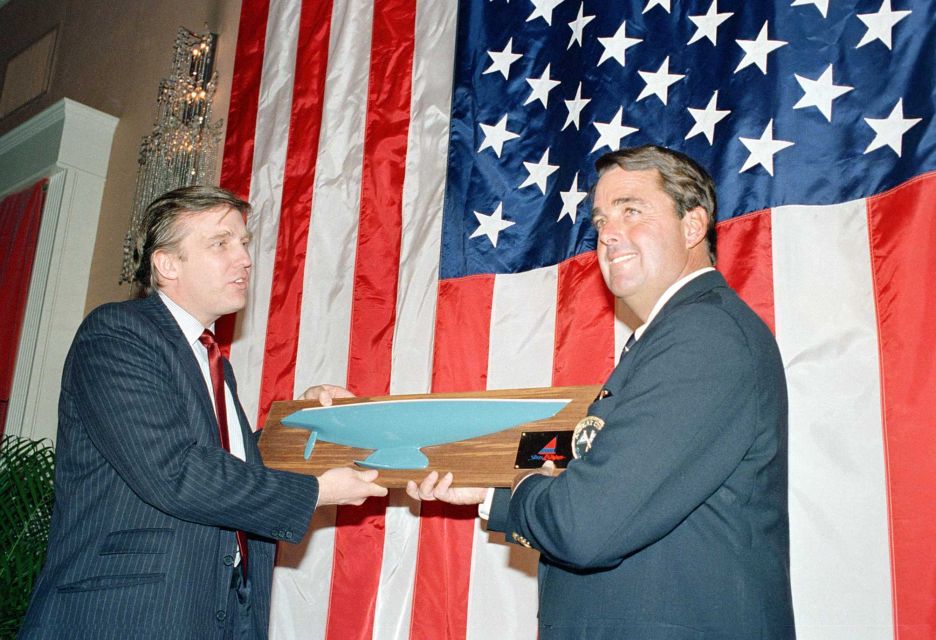
Trump and skipper Dennis Conner, after successful challenge for the America's Cup -
which Trump helped finance - as well as a New York parade for the winners - 1987

Trump with his father and boxing promoter Don King - December 1987
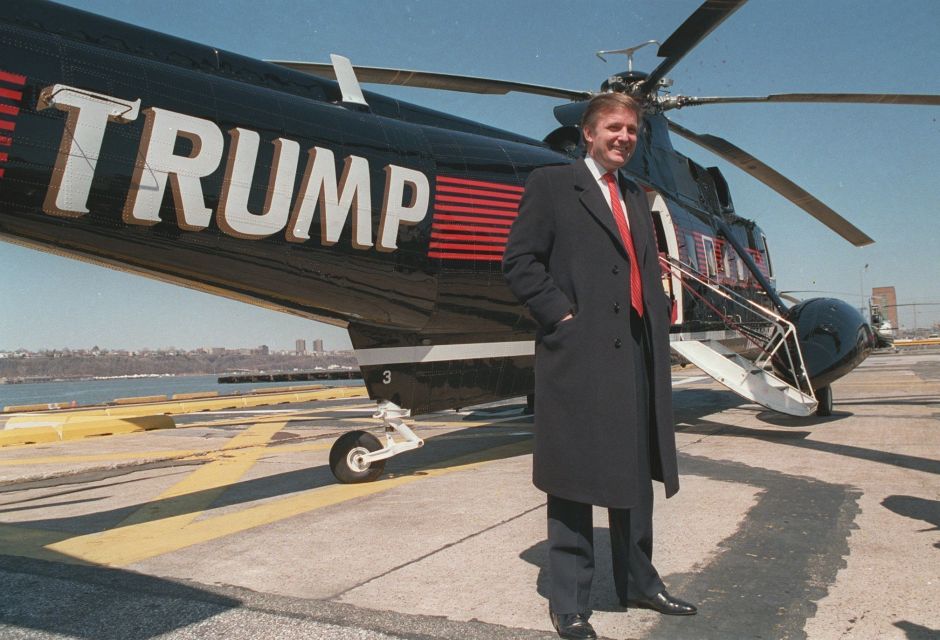
Trump and one of his three Sikorsky helicopters - March 1988
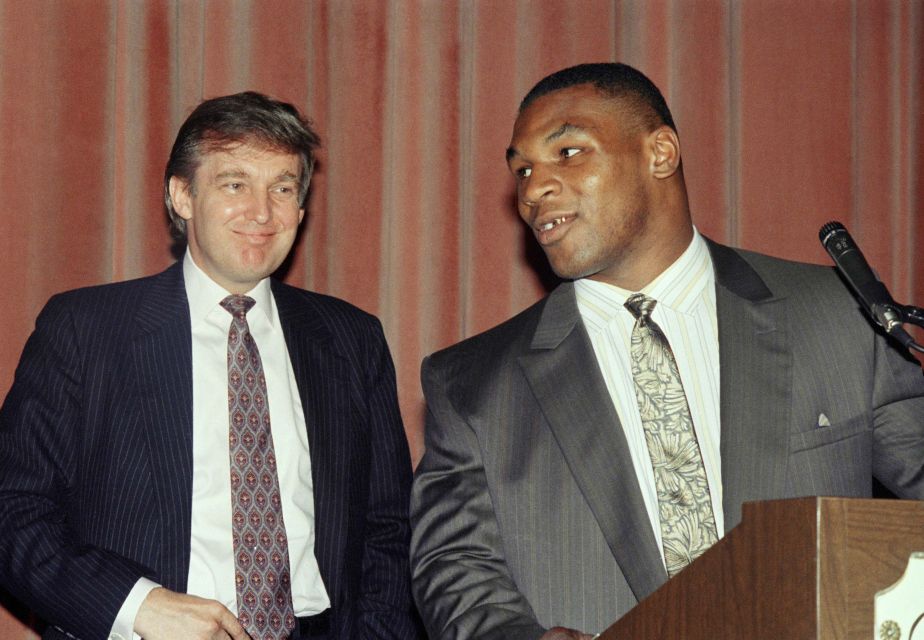
Boxer Mike Tyson and his advistor Trump in front of the press talking about a financial settlement - July 1988

Trump has just agreed to purchase Eastern Airlines' Northeast air shuttle for $365 million - 1988.
IVANA AND FAMILY (1977-1992) |
|
His years of marriage with Ivana (1977-1992) His first wife, Ivana Zelnickova had climbed her way out of obscurity in Communist Eastern Europe, by posturing herself as an olympic skier and a model. She met Trump in 1976 in a singles bar on a visit from Montreal. They were married the next Easter at the Trump family's Marble Collegiate Church by its famous preacher Norman Vincent Peale ... under the terms of a prenuptual agreement (drafted by the sharp Roy Cohn) promising her $20,000 a year (upscaled however over the years, reaching in 1987 a $25 million figure in case of divorce)). They took up residence in a fashionable 5th Avenue apartment with their first child, Donald, Jr. Ivana. Ivana was hard working and had a well developed instinct for self-promotion ... either as part of Donald's business world or on her own. Her grand vision seemed to be to try to duplicate the appearance in her life of the old European aristocracy with their castles and grand doings. Unfortunately, though well-meaning and carefully engineered, her efforts seemed to produce more outward glitz than deep authenticity. Donald. Trump constantly fought boredom: notable when victories came too easily. He enjoyed immensely the challenge of conflict, the more challenging a conflict the better. He loved 'the deal' ... much like gamblers enjoy the table. His deals could be extremely hard on him, but he seemed to relish the expenditure of his energy for just such challenges. What truly grieved him was when his successes came too easily. He grew bored with things quickly. He also gave the appearance of not caring much about where his doings left others. His language was unapologetically abuse of others, especially when aimed at the tabloid press that followed his life so closely. The press loved scandal ... and his doings seemed to translate so easily into such scandal ... especially when recast by the press. As the years went by Donald and Ivana came across to others more as business partners than as husband and wife. Basically she ran Trump Castle for a while. Trump published his book: Trump: The Art of the Deal. Another was about to come out, Trump: Surviving at the Top, just as he was facing his 1989 personal financial meltdown. |

Wedding Day - 1977
 Trump and Ivana in their early years
together
Trump and Ivana in their early years
together


Trump's Mar-a-Logo Estate at Palm
Beach, Florida (purchased in 1985)
which was built by and lifetime home to the
supremely wealthy Marjorie Merriweather Post.
Ivana loved to 'hold court' here with
the
rich and famous.

Trump and Ivana the day she received US citizenship - May 1988

Trump and Ivana hosting their pastor Norman Vincent Peale's 90th birthday party - May 1988

TRUMP'S FINANCIAL CRISIS |
|
Rumors of financial
catastrophe erupt (1989)
In the latter part of 1989 Donald's empire seemed on the verge of collapse. In 1987 the Stock Market crashed and a deep rececession hit the New York real estate market. Construction virtually ceased and many of the major developers went into bankruptcy. Over the next couple of years this calamaty finally began to undercut Trump deeply. By 1990 Trump's cash flow had come to a halt. By 1991 his financial situation was compounded by his very expensive divorce with Ivana over the Marla Maples affair (see the next section). Trump was in deep trouble on all fronts. Meanwhile a nervous Federal Reserve Bank was looking into the real estate market ... requesting banks to take a long hard look at their exposure in the real estate sector. It was at this point that that Trump's finances came under close scrutiny ... revealing how overextended Trump was. He was in danger of bankruptcy if pushed by his lenders. Trump had financed his operations with massive loans from the world of financial capital (as does typically any industrial capitalist). His airline operations, his hotels, his business buildings, his mansions and yacht were all heavily financed ... by as much (as some speculated) as $4 billion owed to over 70 banks - plus $800 million in personal indebtedness. Plaza
Hotel
He had recently (1988) bought the historic Plaza Hotel for $400
million (financed by Citibank) ... and now there was speculation as to whether or not it was
worth that amount ... and what the status of Trump's finances happened
to be actually. Negotiations would continue for the next 18 months. Trump was still hoping to make a comeback with the Plaza Hotel ... but the bankers vetoed his proposal. In the end a deal concerning the Plaza Hotel was finally struck with the creditor banks giving them half of the ownership of the hotel, the forgiveness of $250 million of Trump's debt, and a reduction in the interest rates on the remainder. The Taj Mahal Also acquiring the Taj Mahal had cost Trump majorly. The project had become so expensive that in 1988 the New Jesey Casino Control Commission got Trump to promise to keep expenses within tighter bounds. But in fact he turned around and issued high interest (14%) bonds to investors in the amount of $675 million in order to complete his work on the unfinished casino (but he also siphoned off some of that money to invest in other real estate ventures in Manhattan). In the end he had run up a debt of $820 million in order to open the casino in 1990. He was going to have to have a huge income from the operations of the Taj Mahal (at least $1.3 million a day) just to meet the huge interest payments he had committed himself to. That was something that the Taj Mahal would never be able to achieve. Consequently the Trump debt simply grew with each passing month. By December of 1990 he was not able to make a $18 million interest payment ... and was bailed out by his father who did some manipulation of the Castle's operations to put the cash in Trump's hand ... an illegal move that cost the Castle $65,000 in fines imposed by the New Jersey Casino Control Commission. Furthermore, his new Taj Mahal actually competed with his other two casinos, causing a drop in the earnings of both the Plaza and the Castle by $58 million in the first year of the Taj Mahal's operation. Settlement with the banks (1992) Finally Trump and his creditors came to an agreement concerning his immense debt, in which Trump agreed to give up half of the ownership of the Trump Organization's properties to his creditors ... in exchange for the forgiveness of $250 million of the Trump Organization's debt, and a reduction in the interest rates on the remainder. It was also stipulated that Trump would sell off some of the properties (in particular the Trump Shuttle airline, his private yacht and his holdings in the New York City Plaza Hotel) ... until the real estate market bounced back. They also agreed to forgive him the personal debts he owed the banks ... provided that he worked with them in the sale of these properties (Trump was likely to strike a better deal with purchasers than the bankers themselves). And ultimately his personal operating budget was also to be limited to $450,000 a month. Overall, what Trump got in the deal was a 5-year postponement of the ultimate accountability that had just recently pointed to bankruptcy. But a huge debt remained to be paid off. On top of all that, beginning in 1990 an overall drop in the profitablity of all the casinos hit Atlantic City hard. But worst hit of all were Trump's casinos. Likewise property values dropped in Manhattan because of a recession that the country was suffering from ... making Trump's situation there extremely difficult as well. |

The Plaza Hotel on 5th Avenue opposite Central Park

Trump and Ivana at a Manhattan social event at the time of his supposed financial "melt-down"
December 1989

Trump's Taj Mahal Casino in Atlantic City, NJ - opened in 1990


Trump leaving the courthouse followed by reporters - March 1991
MARLA MAPLES |
|
Scandal
In 1991 a story exploded in the tabloid press about Marla Maples and her encounter with Ivana Trump on the Aspen sky slopes during the last day of 1990. This was possibly Ivana's first indication that Donald had been having more than just a casual relationship (actually it had been going on for about two years - often rather openly) with this attractive young model from Georgia (but there had been others as wel keeping Trump company). That year (1991) Ivana brought divorce procedings against Donald. This all became the talk of the town. While Ivana continued to hold court in the family's triplex in the upper part of Trump Towers, Donald isolated himself from the world in a small apartment further down in the building. The tabloid press was quick to choose sides in the split: Ivana was the distressed heroine, Donald the villain. But Ivana was no one's victim, aiming to hit Donald for half of the Trump assets ... despite the marital agreements signed (and revised over the 14 years of their marriage). The scandal of the Trump separation covered eagerly by the tabloids was also accompanied by much speculation about Trump's financial status overall ... already supposedly in deep trouble. If he was forced to give up half of his assets to Ivana, how would he be able to do that? He was heavily borrowed-up. In the end Ivana elected to receive 'a mere $23 million' in the divorce settlement. And yet ... Donald and Ivana remained friends over the years. In fact her $3 million wedding (her fourth wedding) in 2008 with Rossano Rubicondi (23 years her junior) was hosted at Mar-a-Lago by Donald Trump himself. (But she and Rossana formally separated five months later ... though the marriage continued through an on and off basis thereafter).Moving on with Marla In December of 1993 - two months after the child they had together, Tiffany, was born - he was pressured finally into marrying Marla Maples. Donald and Marla separate and then divorce Donald would divorce Marla in 1999 (after two years of separation), awarding her $1.5 million in settlement ... before she moved her daugher Tiffany and herself to California. There she quickly dropped out of the public's sight. But in 2007 she took up a role in a TV series, The Ex-Wives Club (not making Donald very happy over the matter). |
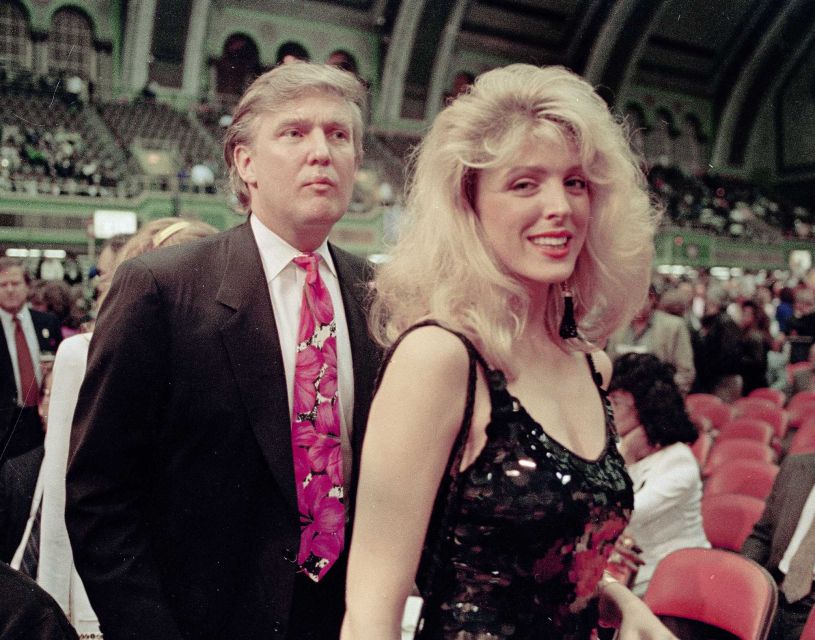
Trump and Marla at a boxing match held in the Atlantic City Trump Plaza - April 1991

Donald Trump and Marla Maples at his second marriage in December of 1993 in New York City
(however they split in May of 1997 and divorced in 1999)

in America and abroad
TRUMP'S CLIMB BACK |
|
In 1997 he would publish his second book, The Art of the Comeback.1
And indeed Trump had slowly achieved just that, a true comeback. In
1994 he was able to acquire 50 percent ownership of the Empire State
Building, and in 1995 finally finish the restoration and sell the Plaza
Hotel (which he renamed the Trump Building). The year after that he
develop a multi-building project along the Hudson River. And from there
he eventually went on to acquire numerous properties in various places
around the country as well as overseas, from office towers to hotels
and golf courses.
1His first book, something of a Trump biography (largely written by Tony Schwartz), was published in 1987 as Trump: The Art of the Deal (New York: Ballantine Books). It would become a New York Times
bestseller for almost a year – and stay of the top of the list for
three months – making the fairly young Trump one of Gallup Poll's
top-10 best-known Americans at the time. |

1997
MELANIA ENTERS THE PICTURE |
During this time he met (1998) and began dating the Slovene model,
Melania Knauss, although it would not be until 2005 that they would
marry. Attending the wedding were numerous political and media
celebrities, including Bill and Hillary Clinton! A little over a year
later Melania would give birth to their son, Barron. |

Trump and the Slovene fashion model Melania Knauss at a New York Giants preseason game - August 1999


Trump's third
wedding (January 22, 2005) - at his Mar-a-Lago
Estate
with his bride Melania ... and Hillary and Bill in
attendance!
TRUMP AS A TV PERSONALITY (THE
APPRENTICE) |

Trump as TV host for
the TV series The Apprentice
/ The Celebrity Apprentice
(2004-2015)
with his
daughter Ivanka and son Donald,
Jr.
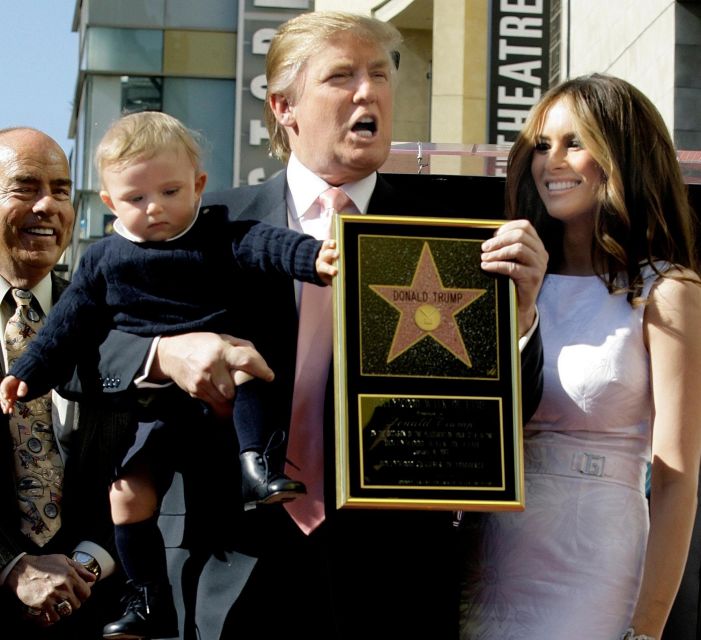
Trump and Melania with their son Barron - being honored in Hollywood - Jan 2007

"You're fired!" Trump hosting The Celebrity Apprentice
AND THE BUILDING PROJECTS (AND OTHER PROJECTS AS WELL) CONTINUE |

Trump Towers Las Vegas (completed 2008)
 Trump Towers
Chicago
(completed 2009)
Trump Towers
Chicago
(completed 2009)

The Trump Ocean Club - Panama City,
Panama - (completed
2011)
(condominium
apartments built in connection with Roger Khafif
under the Trump name and managed
by the Trump organization)

Trump Towers - Mumbai, India
Other Trump
Towers
are found in Miami, Toronto, Turkey
plus other major buildings of a
similar
order in multiple cities ... all of them of unique design
 Go
to the history section: The Trump Presidency Go
to the history section: The Trump Presidency
|










